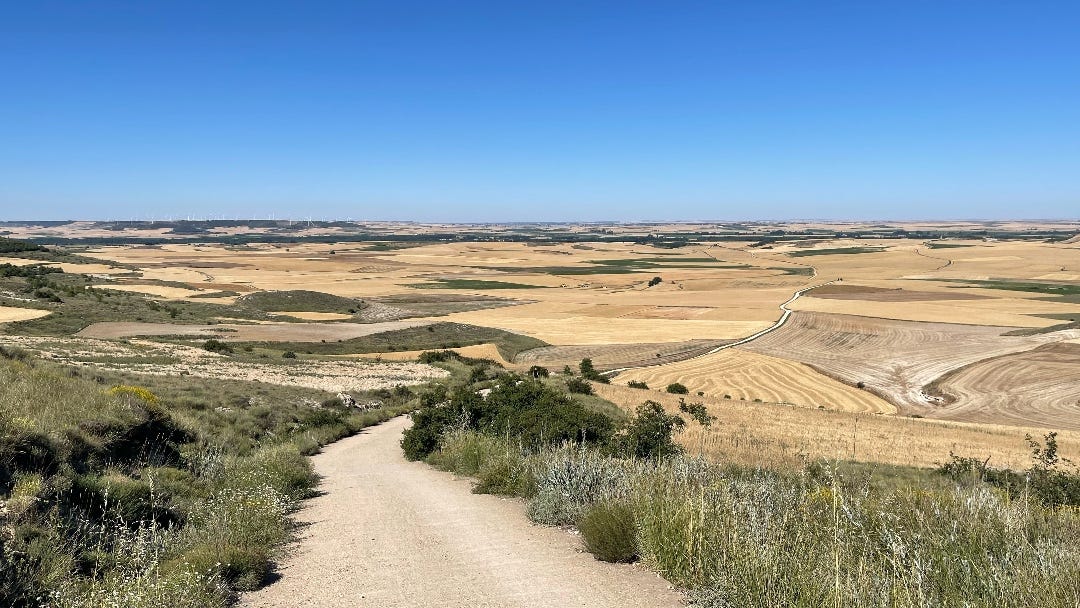insight - Travel and Art - # Discovering Richard Serra's Sculptural Influence during a Journey on the Camino de Santiago
Exploring the Artistic Legacy of Richard Serra on the Camino de Santiago
Core Concepts
The author's personal exploration of Richard Serra's monumental sculptures and their impact on the experience of space, from Bilbao to the Meseta region along the Camino de Santiago pilgrimage route.
Abstract
The content is a travel memoir that reflects on the author's journey through Spain, particularly the Basque Country and the Camino de Santiago pilgrimage route. It begins with the author's visit to the Guggenheim Museum in Bilbao, where they encountered the renowned sculptor Richard Serra's work. This leads the author to contemplate Serra's artistic legacy and how his sculptures shape the perception of space.
The author then describes their decision to travel north from Madrid to the Basque Country, driven by a desire to escape the heat and explore the region's cultural and artistic offerings. This includes visiting the town of Guernica, which was famously bombed during the Spanish Civil War, and rereading Hemingway's "The Sun Also Rises" in preparation for a visit to Pamplona.
As the author continues their journey along the Camino de Santiago, they reflect on the vast, open landscape of the Meseta region and how it evokes a sense of Serra's sculptural concepts. The author draws parallels between the experience of walking through the Meseta and the immersive, transformative nature of Serra's art, suggesting that the Camino de Santiago itself becomes a canvas for the artist's vision.
Throughout the memoir, the author weaves together their personal experiences, literary references, and insights into the enduring impact of Richard Serra's work, creating a thoughtful and engaging exploration of the intersection between art, travel, and the human experience of space.
I Found Art on the Camino de Santiago
Stats
None.
Quotes
"Serra's sculptures imprint themselves on your memories, and the first association isn't the artist's name, but instead, you think of the place where you last saw one of his works."
"Las Meninas teaches visitors a lesson in viewing, reality, and experiencing space."
Key Insights Distilled From
by Alexander Ve... at medium.com 03-30-2024
https://medium.com/travel-memoirs/i-found-art-on-the-camino-de-santiago-19d756280664
Deeper Inquiries
How might the author's experience of the Camino de Santiago have been different if they had not been familiar with Richard Serra's work?
The author's familiarity with Richard Serra's work likely added a unique dimension to their experience on the Camino de Santiago. Serra's concept of space, as reflected in his monumental steel sculptures, could have influenced the author's perception of the physical landscape along the pilgrimage route. Without this prior knowledge of Serra's art, the author may have missed the opportunity to see the Camino through the lens of spatial relationships and artistic expression. The absence of this artistic reference point might have resulted in a less nuanced or layered experience of the journey, potentially overlooking the interplay between art, space, and personal reflection that Serra's work often evokes.
What other artists or art movements might have a similar transformative effect on the perception of space and the experience of a physical landscape?
Several artists and art movements could have a similar transformative effect on the perception of space and the experience of a physical landscape, akin to Richard Serra's impact. For example, the Land Art movement, with artists like Robert Smithson and Nancy Holt, focuses on large-scale environmental works that interact with the natural surroundings, reshaping the viewer's relationship with the land. The Minimalist movement, represented by artists such as Donald Judd and Dan Flavin, explores simplicity, form, and materiality, which could also influence how individuals engage with space and their surroundings. Additionally, the Surrealist movement, with its emphasis on the subconscious and dreamlike imagery, might offer a different lens through which to interpret and experience a physical landscape, challenging conventional perceptions and inviting new perspectives.
In what ways can the Camino de Santiago itself be considered a work of "art" or a canvas for artistic expression, beyond the individual sculptures or installations encountered along the way?
The Camino de Santiago can be viewed as a work of art or a canvas for artistic expression in various ways beyond the individual sculptures or installations encountered along the pilgrimage route. Firstly, the Camino's historical and cultural significance, spanning centuries of religious pilgrimage and human connection, imbues the journey with a profound narrative and symbolic depth that parallels the themes often explored in art. The diverse landscapes, from rugged mountains to serene valleys, serve as a natural backdrop that artists throughout history have drawn inspiration from, capturing the essence of the journey through different mediums. Additionally, the communal aspect of the Camino, where individuals from diverse backgrounds come together in a shared experience of reflection and growth, mirrors the collaborative and interactive nature of many artistic practices, turning the pilgrimage itself into a living, evolving artwork shaped by each participant's unique perspective and contribution.
0
